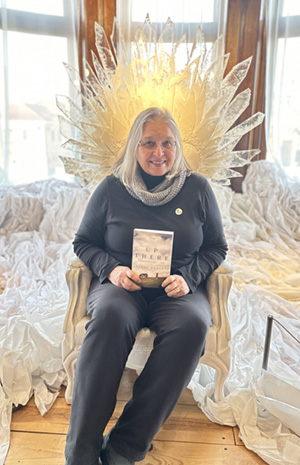We can hardly take a breath without running into stories. There are stories in newspaper, in songs on the radio, in the gossip of our friends. Museums are packed with stories. I ran into the story of the Snow Queen by Hans Christian Andersen and sat on her throne recently at the American Swedish Institute in Minneapolis.
Stories within stories are often more than a flashback that reveals a single memory or a bit of the character’s history. Filmmaker Baz Luhrmann says the story within a story creates a contextual frame. It gives the reader a way to understand why a character does what she does, and why she has become who she has become.
In my novel Up There, I created the story of Harriet Bunyan, the fictional sister of the larger-than-life (and also fictional) lumberjack Paul Bunyan. I depicted her as an early environmentalist who stood up to her big brother to save Nature in Minnesota: “Harriet spent years sprinkling the hillsides with hearty oaks, majestic spruces, rolling sumac, sweet wildflowers, and tall prairie grasses. She wrestled rivers and creeks, twisting them this way and that. She made lakes and ponds with the print of her thumb.”
Although Harriet was the product of a local PR campaign, she was something more to Ariel Lee, the heroine of Up There. Ariel wished to be like Harriet. “Harriet was brave and smart and didn’t tolerate bullies,” Ariel said. “She stood up to her giant brother and saved the land. Harriet Bunyan is my hero.”

I used the Harriet story to show Ariel’s early interest in the environment and also to reveal one of Ariel’s chief fears—that she is not courageous and never will be. (By the way, outside the L.L. Bean store in the Mall of America sits a giant rubber-bottomed boot that just might fit either Paul or his sister Harriet.)
I also employed the technique of telling a story within a story in Book of Mercy, my novel about censorship. The story within the story, “Too Many Words,” is actually a child’s book about a boy who cannot stop the words from falling from his lips even though his parents, the doctors, even the police try to stop him. His mother tells him uncontrollable words is not good; they could make the world “messy.”
To keep his book safe in a world of censors, Stanley the author leaves “Too Many Words”—whose pages are tied together with dental floss and have a cover crafted from a cereal box—on the doorstep of Antigone Brown, a woman fighting book banning in her town. The story within the story illustrates the damage censorship can do to a community and a family. It also expresses the bravery it takes for Antigone to stand up for books and the hunger all children have for ideas.
I hope you look for stories wherever you go.
Even if I enter a house where there are no books (a place that hurts my heart), I still believe there are stories inside those walls and people yearning for those stories. As writer and journalist Joan Didion said, “We tell ourselves stories in order to live.”
______________________________________
Up There is the winner of the 2024 Minnesota Indie Writer Project Contest. Up There explores love, small-town life, the environment, and one woman’s quest to find herself. It is available in paperback and eBook.


